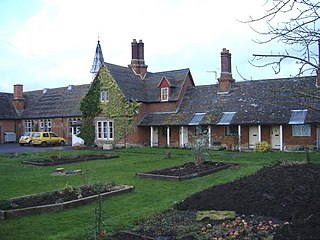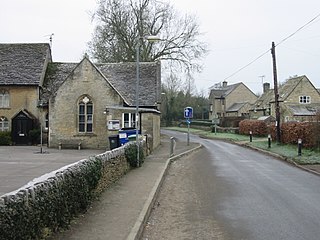
Malmesbury Abbey, at Malmesbury in Wiltshire, England, is a former Benedictine abbey dedicated to Saint Peter and Saint Paul. It was one of the few English religious houses with a continuous history from the 7th century through to the Dissolution of the Monasteries.

Amesbury is a town and civil parish in Wiltshire, England. It is known for the prehistoric monument of Stonehenge which is within the parish. The town is claimed to be the oldest occupied settlement in Great Britain, having been first settled around 8820 BC. The parish includes the hamlets of Ratfyn and West Amesbury, and part of Boscombe Down military airfield.
Sir John Danvers was an English courtier and politician who was one of the signatories of the death warrant of Charles I.

Glastonbury Abbey was a monastery in Glastonbury, Somerset, England. Its ruins, a grade I listed building and scheduled ancient monument, are open as a visitor attraction.

The King's Head is one of the oldest public houses with a coaching yard in the south of England. It is located in the Market Square, Aylesbury, Buckinghamshire, and is a Grade II* Listed Building.

Castle Combe is a village and civil parish in Wiltshire, England. The village is around 5 miles (8 km) north-west of Chippenham and 10 miles (16 km) north-east of Bath. At the 2021 census, the parish had a population of 356.

Wiltshire is a historic county located in the South West England region. Wiltshire is landlocked and is in the east of the region.

The Tudor architectural style is the final development of medieval architecture in England and Wales, during the Tudor period (1485–1603) and even beyond, and also the tentative introduction of Renaissance architecture to Britain. It followed the Late Gothic Perpendicular style and, gradually, it evolved into an aesthetic more consistent with trends already in motion on the continent, evidenced by other nations already having the Northern Renaissance underway Italy, and especially France already well into its revolution in art, architecture, and thought. A subtype of Tudor architecture is Elizabethan architecture, from about 1560 to 1600, which has continuity with the subsequent Jacobean architecture in the early Stuart period.

Abbey House Gardens is a country house garden in Malmesbury, Wiltshire, England, covering 5 acres (2.0 ha). The garden was transformed in the 1990s by the so-called Naked Gardeners: Ian and Barbara Pollard. In 2021 the property was acquired by new American owners, Whit and Kim Hanks. They plan to convert the house into a boutique hotel, while ensuring that the gardens are regularly opened to the public. During the 2022 summer season the gardens were opened from May to October on the second Saturday of each month.

Wardour Castle or Old Wardour Castle is a ruined 14th-century castle at Wardour, on the boundaries of the civil parishes of Tisbury and Donhead St Andrew in the English county of Wiltshire, about 15 miles (24 km) west of Salisbury. The castle was built in the 1390s, came into the ownership of the Arundells in the 16th century, and was rendered uninhabitable in 1643 and 1644 during the Civil War. A Grade I listed building, it is managed by English Heritage and open to the public.

Dauntsey is a village and civil parish in Wiltshire, England. It gives its name to the Dauntsey Vale in which it lies. The village is set on slightly higher ground in the floodplain of the upper Bristol Avon.

Moreton Corbet Castle is a ruined medieval castle and Elizabethan era manor house, located near the village of Moreton Corbet, Shropshire, England. It is a Grade I listed building and English Heritage property. Although out of use since the 18th century, it remains the property of the Corbet family. It can be visited free of charge during daylight hours.

Devizes Castle was a medieval fortification in the town of Devizes, Wiltshire, England, on a site now occupied by a Victorian-era castle. It is a Grade I listed building. The original castle was overbuilt by the current structure. Records indicate that the first castle on the site had its origins in about 1080 as an early Norman motte and bailey with wooden pallisade and tower.

Oaksey is a village and civil parish in Wiltshire, England, on the county boundary with Gloucestershire. The village is about 6 kilometres (3.7 mi) northeast of the market town of Malmesbury and a similar distance south south west of the Gloucestershire market town of Cirencester.

Malmesbury is a town and civil parish in north Wiltshire, England, which lies approximately 14 miles (23 km) west of Swindon, 25 miles (40 km) northeast of Bristol, and 9 miles (14 km) north of Chippenham. The older part of the town is on a hilltop which is almost surrounded by the upper waters of the Bristol Avon and one of its tributaries.

St Mary's Church in the village of Purton in north Wiltshire, England, is an active Church of England parish church in the Diocese of Bristol. A large building begun in the 13th century and one of only three churches in England to have both a western tower and a central spire, it has been designated as a Grade I listed building by English Heritage.

Crudwell is a village and civil parish in north Wiltshire, England. The nearest towns are Malmesbury, about 4 miles (6.4 km) to the south-west, and Cirencester, Gloucestershire 8 miles (13 km) to the north-east. Also to the north-east is Cotswold Airport. Kemble village, about 4 miles (6.4 km) away, has the nearest railway station, with services to London Paddington and Gloucester.
Malmesbury Castle was a castle in the town of Malmesbury, Wiltshire, England.
The Old Bell or Olde Bell may refer to:

In British usage, the term townhouse originally referred to the opulent town or city residence of a member of the nobility or gentry, as opposed to their country seat, generally known as a country house or, colloquially, for the larger ones, stately home. The grandest of the London townhouses were stand-alone buildings, but many were terraced buildings.





















